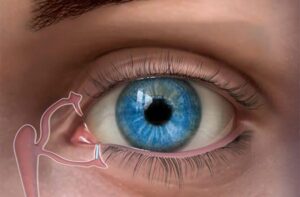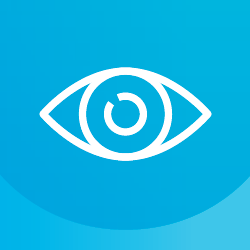In a world where every detail matters, where every moment counts, we understand that the clarity of your vision is not just a matter of health – it’s a vital part of your everyday life. At Modern Vision Solutions, we know that struggling with refractive errors can be more than just an inconvenience; it can be a journey filled with confusion, discomfort, and a quest for answers.
Whether you are squinting to read your favorite book, experiencing headaches after a long day at work, or simply wishing to see the world more clearly, we recognize your challenges. Refractive errors, like near-sightedness, far-sightedness, astigmatism, or presbyopia, affect not just your sight, but how you experience life.
Stay with us as optometrist Dr. Meagan Anderson takes us deeper into the topic of refractive errors, offering you the insights and information you need. At Modern Vision Solutions, your vision, comfort, and time are our top priorities.
Understanding the Eye: The Gateway to Vision
To fully appreciate the complexities of refractive errors, it’s essential to understand how vision works. This journey begins with the miraculous anatomy of the human eye, a sophisticated organ designed to capture and interpret light, transforming it into the images we see.
Your Eye’s Anatomy: A Window to the World
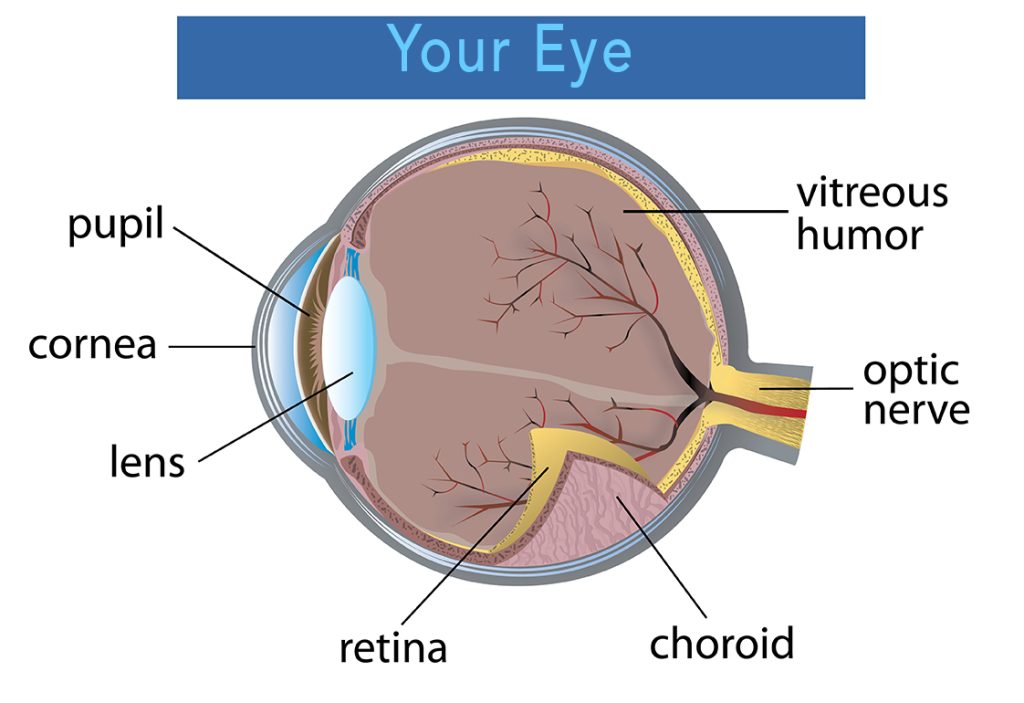
- Cornea: This clear, dome-shaped surface at the front of your eye acts like a camera lens. It bends (refracts) incoming light, starting the process of creating an image.
- Pupil: This is the black circular opening in the iris (the colored part of your eye). It regulates the amount of light entering the eye, much like the aperture of a camera.
- Lens: Located behind the pupil, the lens further refocuses light onto the back of your eye. It changes shape to adjust focus, enabling you to see objects at different distances.
- Retina: This light-sensitive layer of tissue at the back of your eye converts light into electrical signals.
- Optic Nerve: These signals travel along the optic nerve to your brain, where they are interpreted as the images you see.
The Process of Seeing: From Light to Sight
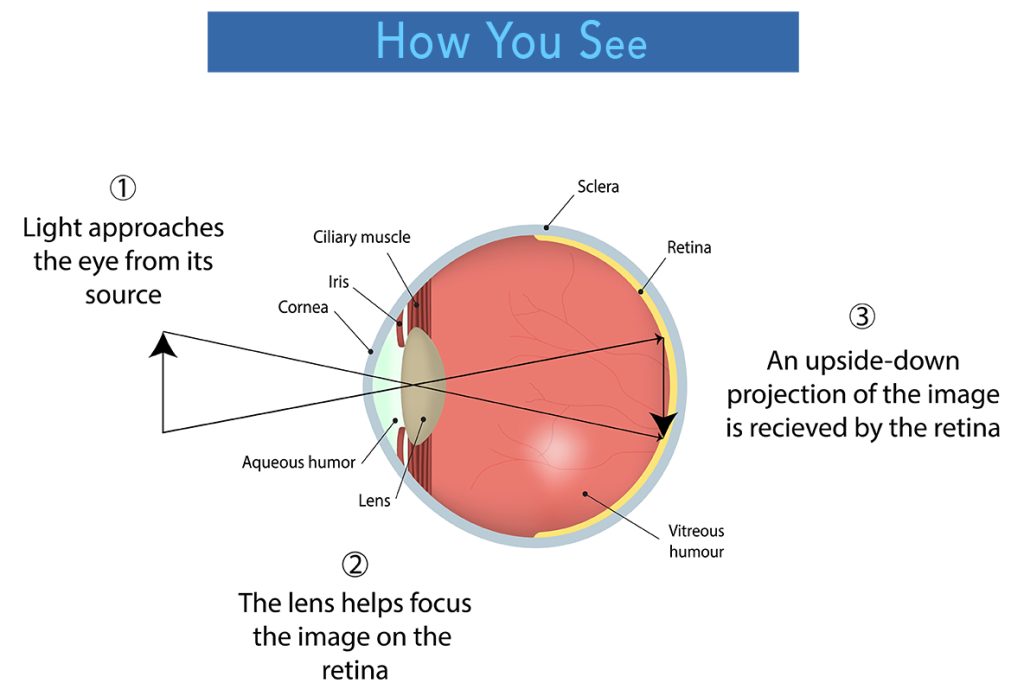
- Capturing Light: When light enters your eye, it first passes through the cornea. Here, the light begins to bend, a crucial step in creating a clear image.
- Adjusting Focus: As light moves through the lens, its shape changes to further refine the focus of the light rays. This process is essential for clear vision at various distances.
- Forming the Image: The focused light rays converge on the retina, creating an image. This image is initially upside down and reversed.
- Transmission to the Brain: The retina’s photoreceptor cells convert this image into electrical impulses that are sent to the brain through the optic nerve.
- Perception of Sight: Your brain receives these impulses and flips the image into the correct orientation, allowing you to perceive the world as it is.
In Perfect Harmony: The Eye and Brain Connection
The intricate relationship between the eye and the brain is a testament to the complexity and wonder of the human body. Together, they work to not only capture and focus light but also to interpret and understand the visual world around us.
At Modern Vision Solutions, we understand the importance of each component in this delicate process. Our goal is to ensure that your eyes function at their best, providing you with the clearest vision possible. Whether it’s through glasses, contact lenses, or surgery, our focus is on optimizing the way light travels through your eye, ensuring that the images reaching your brain are as sharp and accurate as they can be.
In our next section, we will delve into the specifics of refractive errors – what they are, how they affect your vision, and the modern solutions available to address them.
What is a Refractive Error?
Refractive errors occur when the shape of your eye prevents light from focusing correctly on the retina, the light-sensitive tissue at the back of your eye. This misalignment results in blurred vision, the most common symptom of refractive errors. The main types of refractive errors include near-sightedness (myopia), far-sightedness (hyperopia), astigmatism, and presbyopia.
What Types of Refractive Errors Are There?
Near-Sightedness (Myopia): Here, the eye is longer than normal or the cornea is too curved, causing light rays to focus in front of the retina. This makes distant objects appear blurry.
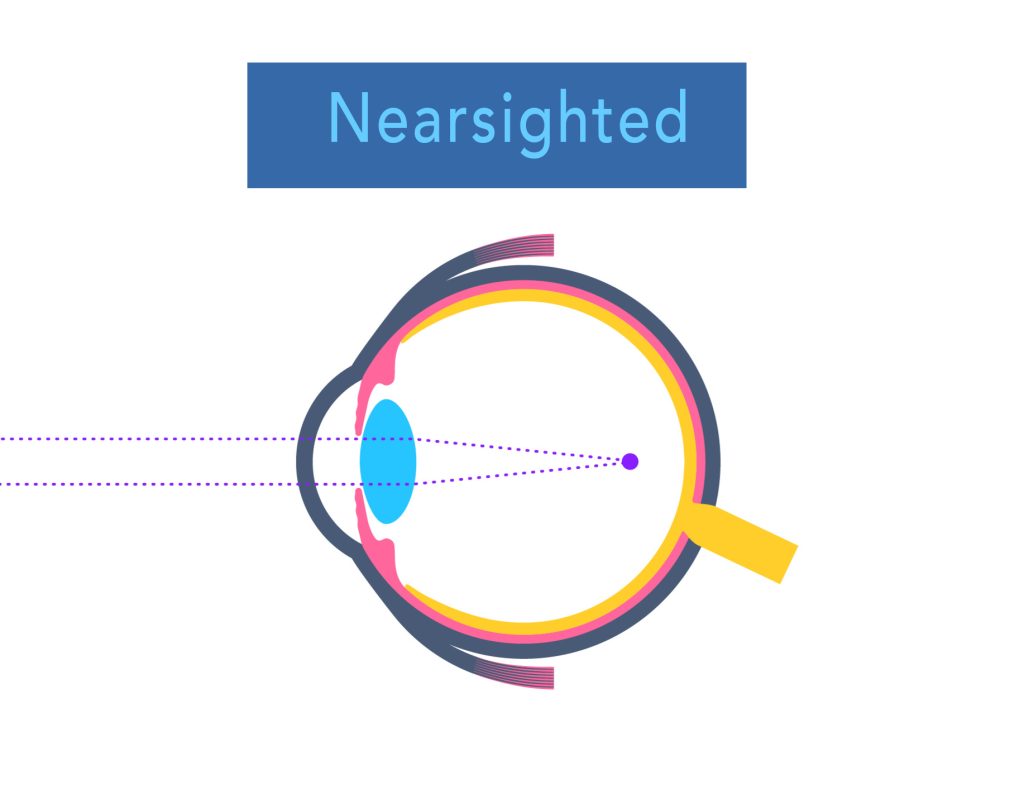
Far-Sightedness (Hyperopia): In this condition, the eye is shorter than normal or the cornea is too flat, causing light to focus behind the retina. It makes close objects appear blurry.
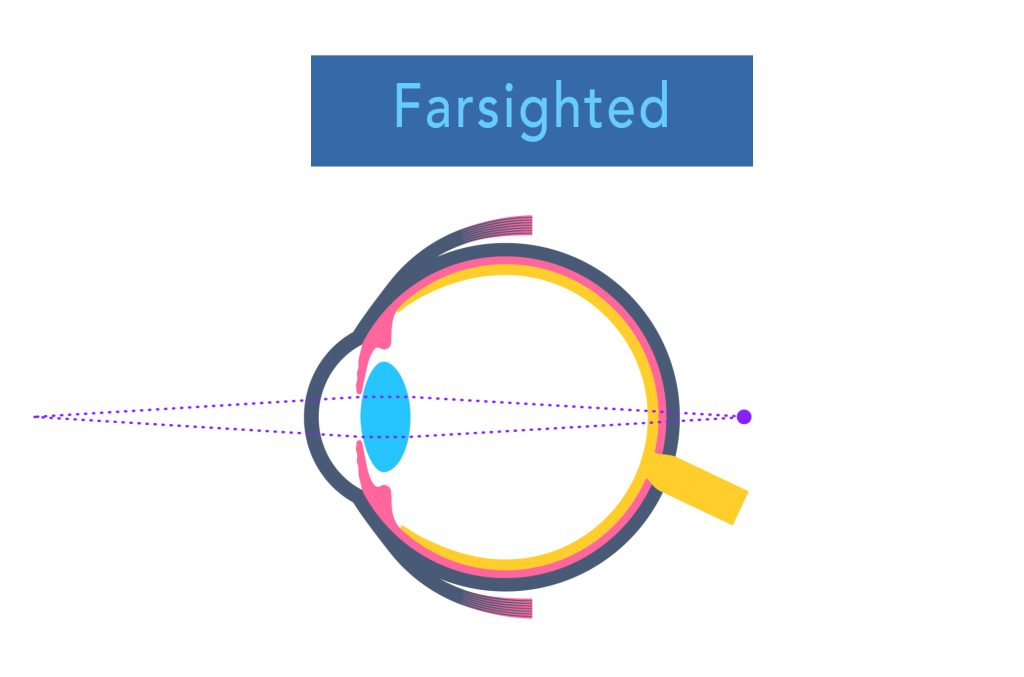
Astigmatism: This occurs due to an irregularly shaped cornea or lens, leading to blurred or distorted vision at all distances.
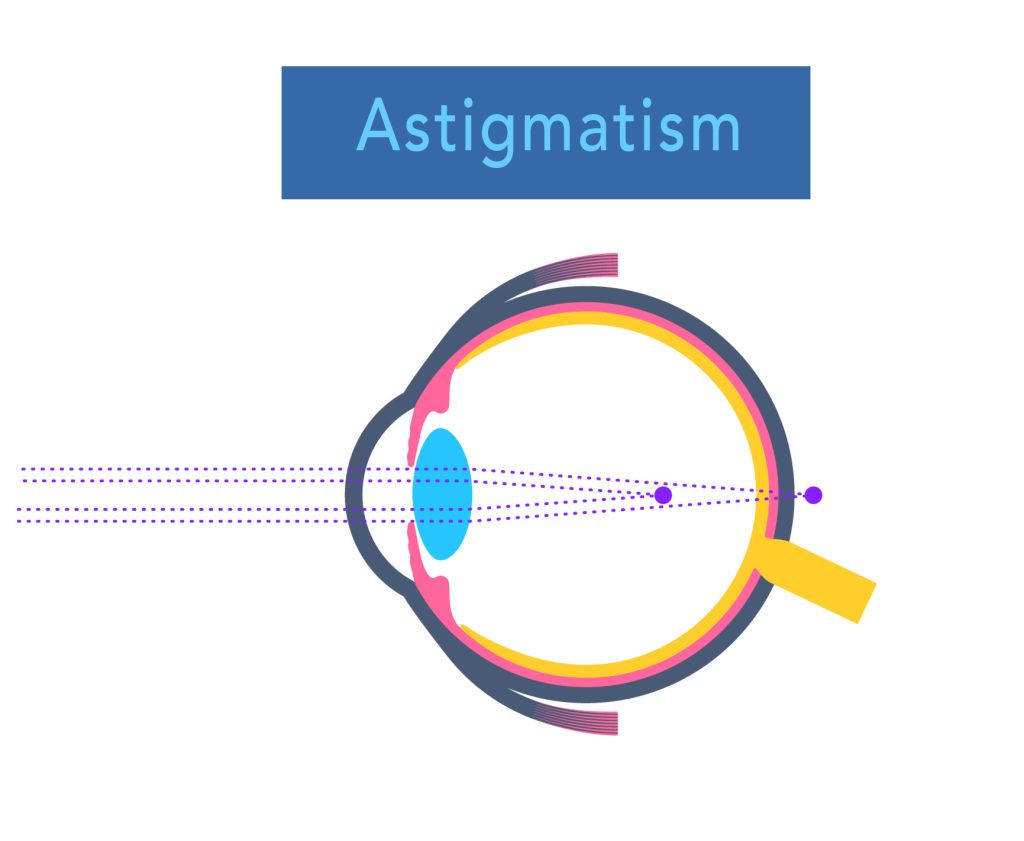
Presbyopia: An age-related condition where the lens becomes less flexible, making it hard to focus on close objects.
What are the Symptoms and Signs of Refractive Errors?
Beyond blurred vision, refractive errors can manifest in various ways. Some common signs and symptoms include:
- Difficulty reading or seeing close objects clearly (hyperopia or presbyopia)
- Problems seeing distant objects (myopia)
- Squinting, eye strain, and headaches, often resulting from the extra effort to focus
- Double vision or seeing halos around lights, common in astigmatism
These symptoms can have a significant impact on your daily activities, from driving to reading to using a computer. At Modern Vision Solutions, we understand that these challenges can affect your quality of life, and we’re dedicated to providing solutions that cater to your unique visual needs.
How are refractive errors diagnosed?
Refractive errors are best diagnosed through a comprehensive eye examination. At Modern Vision Solutions, your exam is the first step in diagnosing refractive errors. Our state-of-the-art digital eye exams ensure accuracy and comfort, without the need for dilation or air puffs for qualifying patients. This process includes:
- Visual Acuity Test: Using an eye chart to measure how well you see at different distances.
- Refraction Assessment: Determining the appropriate lens prescription to correct your vision.
- Eye Health Evaluation: Examining the eye’s internal and external structure for any other issues.
At Modern Vision Solutions, we recognize that each patient’s vision is unique. Our focus is on providing a comprehensive, personalized approach to eye care. From next-day appointments to family eye exams, we ensure that your journey to clearer vision is as seamless and convenient as possible. Our transparent pricing and ‘No-Pressure Promise’ means you can trust us to prioritize your vision and health, not sales.
What are the causes of refractive errors?
Refractive errors are primarily caused by irregularities in the eye’s structure, that can lead to blurry vision. These irregularities disrupt the eye’s ability to focus light precisely on the retina. Understanding these causes is key to finding the most effective solutions for each individual’s needs.
1. Genetic Factors: Inherited Traits
Many refractive errors are linked to genetics. If your parents have certain types of refractive errors, like myopia (nearsightedness) or hyperopia (farsightedness), you’re more likely to develop them too. This genetic predisposition affects the development and shape of your eyes.
2. Age-Related Changes
As we age, our eyes undergo natural changes. One common age-related refractive error is presbyopia, which typically begins in the early to mid-40s. This condition arises as the lens inside the eye becomes less flexible, making it harder to focus on close objects.
3. The Shape of the Eye
The length of the eyeball and the shape of the cornea play crucial roles in focusing. If the eyeball is too long, as in myopia, or too short, as in hyperopia, or if the cornea has an irregular shape, as in astigmatism, it can lead to refractive errors.
4. Changes in the Eye’s Lens
Changes in the lens of the eye, such as developing cataracts, can also affect your refractive power. These changes might alter the way light passes through the lens, leading to blurred vision.
5. Lifestyle and Environmental Influences
Certain lifestyle choices and environmental factors can contribute to the development of refractive errors. For instance, extensive close-up work, like reading or using computers, may be associated with a higher risk of myopia. Additionally, insufficient outdoor activity during childhood has been linked to a higher risk of developing myopia.
6. Health Conditions and Medications
Some health conditions, such as diabetes, can affect your eyesight. Certain medications can also alter the eye’s ability to focus, temporarily causing refractive errors.
A Focus on Prevention and Management
At Modern Vision Solutions, we understand that while some causes of refractive errors cannot be prevented, early detection and appropriate management can help maintain optimal vision. We advocate for regular eye examinations, especially for children and older adults, as these groups are more susceptible to rapid changes in vision.
Our approach is not just about treating the symptoms but understanding and addressing the underlying causes wherever possible. Whether it’s providing the right prescription for glasses or contact lenses, or discussing surgical options like LASIK or other refractive surgeries, we tailor our solutions to your specific needs and lifestyle.
How are refractive errors treated?
Refractive errors are treated by adjusting the way light rays enter your eye, so it focuses correctly on the retina. There are several effective solutions available, each tailored to different needs and lifestyles. At Modern Vision Solutions, we are committed to helping you find the best option to suit your vision requirements.
Eyeglasses
Eyeglasses are the most common and straightforward solution for correcting refractive errors. They work by compensating for the irregularities in your eye’s ability to focus light.
- Customization: Glasses can be customized for different types of refractive errors, including myopia, hyperopia, astigmatism, and presbyopia.
- Variety: Modern Vision Solutions offers a wide range of frames and lenses to fit your style and vision needs.
- Convenience: Glasses are easy to wear, require minimal maintenance, and can also be a fashion statement.
Contact Lenses
Contact lenses sit directly on the eye, offering a more natural vision correction experience. They are an excellent option for those who prefer not to wear glasses or for certain activities like sports.
- Types: There are various types of contact lenses, including soft lenses, rigid gas-permeable lenses, and specialized lenses for specific conditions.
- Considerations: It’s important to follow proper hygiene and care routines with contact lenses to maintain eye health.
Refractive Surgery
For those seeking a more permanent solution, refractive surgery adjusts the shape of the cornea to correct the refractive error.
- LASIK: The most well-known type, LASIK involves reshaping the cornea with a laser. It’s suitable for a range of refractive errors.
- Other Procedures: Other surgical options include PRK (photorefractive keratectomy), LASEK, and refractive lens exchange or RLE. The best procedure for you depends on various factors like the type and severity of your refractive error, your eye health, and lifestyle needs.
Understanding the Right Choice for You
At Modern Vision Solutions, we understand that the choice of treatment is deeply personal and varies from one individual to another. Our team is dedicated to providing detailed consultations to help you understand the benefits and considerations of each option. We believe in empowering our patients with knowledge and providing a comfortable, pressure-free environment to make the best decision for their vision and lifestyle.
Seeing Clearly Into Your Future: Take the Next Step with Modern Vision Solutions
Our approach at Modern Vision Solutions is centered around providing personalized care that caters to your unique vision needs. We prioritize your convenience and comfort, offering next-day appointments and efficient digital eye exams. Our range of services, from a wide selection of eyeglasses and contact lenses to advanced surgical options, is designed to empower you with choices that fit your lifestyle.
We believe in a partnership approach to vision care, where your needs and health are paramount. Our team is dedicated to not only correcting your vision but ensuring your overall eye health. Whether you’re considering glasses, contact lenses, or refractive surgery, we provide expert guidance and support.
Take the first step towards clearer vision by scheduling an appointment with Modern Vision Solutions. Join us at Modern Vision Solutions, where your vision and comfort are our top priorities, and embark on a journey to a fuller, more vibrant life.
Modern Vision Solutions – Where clarity meets convenience for every family in Omaha.
More FAQ’s About Refractive Errors
What are common types of refractive errors and how are they diagnosed?
The most common refractive errors include nearsightedness (myopia), farsightedness (hyperopia), and astigmatism. These errors are the are diagnosed using various tests in optometry and ophthalmology. At Modern Vision Solutions, we use retinoscopy and other advanced diagnostics to determine the specific type of refractive error and prescribe the correct eyeglasses or contact lenses.
Can refractive errors cause visual impairment and how are they treated?
Yes, refractive errors can lead to visual impairment if not corrected. Treatment options include corrective lenses like eyeglasses or contact lenses, and various forms of eye surgery. Modern Vision Solutions offers comprehensive care for these conditions, using personalized eyeglass prescriptions and advanced surgical techniques to correct refractive errors and improve visual perception.
Are there specific considerations for refractive error treatments in aging adults?
Yes, aging adults may face unique challenges, such as presbyopia or the onset of age-related conditions like macular degeneration. Modern Vision Solutions tailors treatment for aging adults, considering factors like lens flexibility and overall eye health. This may include multifocal glasses, reading glasses, or surgical options depending on the individual’s needs.
Can refractive errors be a sign of underlying health issues or genetic disorders?
Refractive errors can sometimes indicate underlying health issues or genetic disorders. For instance, sudden changes in vision might signal diabetes or other systemic health problems. At Modern Vision Solutions, we recommend regular eye exams as they can be crucial in detecting such conditions early.
What are some common eye disorders in children? How does Modern Vision Solutions treat them?
In pediatrics, common eye disorders include refractive error in children, such as nearsightedness (myopia) and farsightedness (hyperopia), as well as conditions like amblyopia and strabismus. Modern Vision Solutions uses advanced diagnostics and treatments, including corrective lenses and eye exercises, to address these disorders. Our pediatric ophthalmology and strabismus specialists are experienced in managing these conditions, ensuring the best care for young patients.
How does Modern Vision Solutions address vision impairment due to refractive errors?
At Modern Vision Solutions, vision impairment caused by refractive errors is addressed through comprehensive diagnosis and tests, including visual acuity testing and retinoscopy. We offer a range of corrective refraction solutions like glasses or contacts, and surgical options for more severe cases. Our team stays updated with global health trends and data and statistics from the national eye institute to provide the most effective treatments.
Can refractive errors lead to complications like diplopia or retinal detachment?
Yes, certain refractive errors, if left uncorrected, can contribute to complications like diplopia (double vision) or, in rare cases, contribute to conditions that may lead to retinal detachment. Modern Vision Solutions conducts thorough medical diagnosis and uses the latest technology in optics to detect and manage these issues early, focusing on patient safety and effective treatment.
How does Modern Vision Solutions ensure accurate diagnosis of complex eye conditions?
Accurate diagnosis of complex eye conditions, like anisometropia (unequal refractive power in each eye), requires precise testing. At Modern Vision Solutions, we employ advanced techniques like dilated eye exams and focus on detailed eye focus assessments. Our eye doctors participate in grand rounds and residency programs to stay abreast of the latest developments in eye care.
How does Modern Vision Solutions cater to patients with specific needs, like those with low vision or different orientations?
Modern Vision Solutions caters to patients with specific needs, including those with low vision or challenges in focusing on different points or objects close by. We offer specialized eye examinations that consider different orientations and focal points, ensuring that our corrective lenses and treatment plans are tailored to each patient’s unique requirements. Our commitment to individualized care ensures that all patients, including young adults and those with common eye conditions, receive the best possible vision care.







